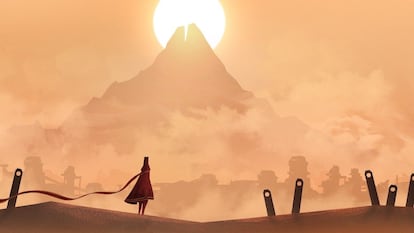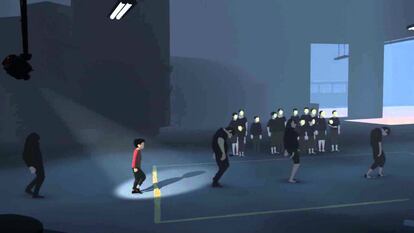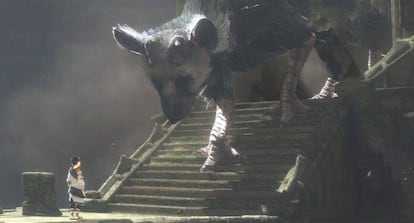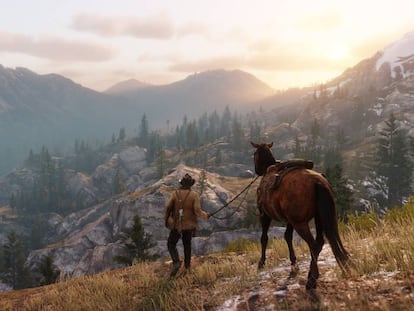Blockbusters, massive competitions and ambitious narratives: How video games move between culture, industry and addiction
A new essay examines the unstoppable advance of digital adventures and their impact in society, highlighting the increasingly risky and experimental creations and analyzing the main pitfalls of the field

At one end of the dark screen, a small white line. Opposite, another. Between them a square dot moves from side to side, while a couple of numbers keep score above. That’s it. Thus, the Pong player was not only required to have some skill with the controller to move their line up and down, trying to hit that little white speck; they also needed to use their imagination in order to believe that they were actually hitting a ball in a fast-paced game of table tennis.
More than 50 years have passed since the release of the first massively commercially successful video game, and practically everything has changed. Today, there are million-dollar blockbusters, online competitions where thousands of gamers participate, sophisticated and complicated plots, state-of-the-art consoles and controllers and photorealistic graphics that hardly require any imagination at all. Nevertheless, the underlying debate still resembles a match of Pong: two sides in a black and white dispute. Just the opposite of what the recently published essay El siglo de los videojuegos (The century of video games), by specialized journalists Jorge Morla from EL PAÍS and Borja Vaz from El Cultural, sets out to do. Below we present some of the key points of the book.

They are everywhere around us
One does not need to read the 219 pages of the essay to realize the importance of the sector. You also don’t need numbers of users or sales figures. All you have to do is look around to see subway passengers tending farms on their cell phones; successful series and films inspired by video games; exhibitions that celebrate them; iconic characters in ambitious narratives; huge creative processes that take many years, millions of dollars and hundreds of workers to develop; the involvement of companies like Netflix, Google or Amazon, all while a myriad of tiny companies create all kinds of risky bets from all corners of the planet.
The growing relevance of video games is an undeniable fact. “The new generations are moving away from traditional and analog forms of culture and are increasingly embracing video games as a way of receiving cultural impacts,” says Morla. “And we see that impact in everything around us: from work to applications. They are not only the cultural artifact that moves the most money, but also the one that shapes the world the most.”

The Last of Us, Mass Effect, Red Dead Redemption 2, Journey, Portal and Gone Home are but a handful of examples of the “stupendous, critical, exorbitantly creative, groundbreaking, brave and non-conformist titles” that the interactive world is currently producing. Whoever thinks that playing with a controller equals shooting or scoring goals would be surprised to find out that they could also play a customs officer for a dictatorship in Papers, Please, solve a marital crisis in It Takes Two or investigate a detainee’s recordings in Her Story. The involvement of famous actors and screenwriters in a video game is no longer news; nor is the fact that some titles are co-produced by museums and universities, or focused on topics like childhood cancer or mental health.

From youth to maturity
The first video game, Tennis for Two, was created in 1958. The medium is not even 70 years old. And yet, two-dimensional table tennis has made way to soccer matches that don’t differ much from what you would see at the stadium; all those princes and plumbers who used to jump from platform to platform to rescue damsels pale in comparison next to the daring and powerful female warriors of today; and while Pac-Man only knew four directions and insatiable hunger, the protagonists of contemporary titles talk and face moral dilemmas, the controller vibrates and sounds and the player feels adrenaline, chills, even tears. In no other artistic field does the consumer become so involved in the narrative structure, as the essay points out.

The book notes that this increase in depth also means a growth in complexity. While Pong only required the player to turn a wheel to move the line up and down the screen, the controller of the PlayStation 5, Sony’s latest console, has 19 buttons. Just learning how to move the character is enough to discourage a first timer. Certain combinations even require special training. And there’s more: the most immersive entertainment is also the most expensive. The big releases can cost $80 and require consoles of at least $300, even if they do provide dozens of hours of entertainment. On the other hand, therein lies another barrier: the very long or very difficult adventures, which the most committed gamers adore, are a turnoff for those who only want some casual fun. Finally, age is also considered a boundary: even though it is advancing, the essay places the limit at around 40 years.

Urban legends and truths
The stereotypes associated with video games have been around for almost as long as the games themselves. And while it is probably true that many of the best-known titles include high doses of violence or dull entertainment, “almost all the big blockbusters have undeniable cultural ambitions in which these stereotypes do not apply – except for violence, which is a resource like any other and must be normalized, as it is in literature or film,” says Vaz. Despite the absence of definitive studies, the alleged relationship between killing or injuring with a controller and doing it in real life continues to generate headlines and controversy.
Another common label, that of “addictive,” also has a double reading, according to the authors. “Although the scientific evidence is not conclusive, there is a potential number of gamers who play compulsively, where the activity takes up a place in their life that it should not, a disorder that harms them […]. Are video games to blame? Some, yes. Others, never. It is very difficult to become addicted to a narrative game with a beginning, middle and end,” elaborates the book. “The main problem is that if we are mired in the same old tired debates, we will never be able to delve into the narrative, aesthetic and mechanical innovations that are being offered,” adds Vaz.

Defeating problems
It would take an extremely skilled player to take on all the villains in the sector. Sexism, harassment and crunch (compulsory overtime), a very reactionary and noisy portion of the public, loot boxes that can push the user to spend compulsively, products that are launched too soon with technical failures, or endless sequels. The essay mentions almost all of them, hunting for answers that are as complex as the problems themselves.
It talks about how, for years, games were aimed at an audience of young straight white males – the same demographic that was creating them. And the power of money-hungry executives, the lack of originality and the unwillingness to take risks is undeniable. But the essay also mentions the war that arose within the sector, fighting for progress and inclusion. “On one hand, there is a very critical group that denounces the condemnable behaviors (the cases of sexism in Ubisoft or Activision, for example, or the reports about crunch),” points out Morla. Complaints that, in his opinion, have served to greatly improve both aspects of video games. On the other, the book speaks of a “toxic audience” and a “very vociferous minority” to refer to those who follow the dispute between Sony and Microsoft as an act of faith or who bombarded The Last of Us Part II with negative reviews because its female leads were part of the LGBTQ+ community.

“The sequels are not a problem, because the mechanics become more refined with each new installment. It is normal for sagas to exist,” reflects Morla. As for the loot boxes, he points out that a distinction must be made between those that require money and those that do not, and believes that the former should be regulated: “We must keep an eye on the most abusive ones.” Even more when minors can access them.
Let’s play
The essay includes a list of masterpieces, described as “modest, partial and incomplete” and ordered by difficulty of access for the public. Of these, Morla and Vaz highlight five that are easy to play: What Remains of Edith Finch, Inside, Stanley Parable, Braid and The Legend of Zelda: Breath of the Wild.

Sign up for our weekly newsletter to get more English-language news coverage from EL PAÍS USA Edition
Tu suscripción se está usando en otro dispositivo
¿Quieres añadir otro usuario a tu suscripción?
Si continúas leyendo en este dispositivo, no se podrá leer en el otro.
FlechaTu suscripción se está usando en otro dispositivo y solo puedes acceder a EL PAÍS desde un dispositivo a la vez.
Si quieres compartir tu cuenta, cambia tu suscripción a la modalidad Premium, así podrás añadir otro usuario. Cada uno accederá con su propia cuenta de email, lo que os permitirá personalizar vuestra experiencia en EL PAÍS.
¿Tienes una suscripción de empresa? Accede aquí para contratar más cuentas.
En el caso de no saber quién está usando tu cuenta, te recomendamos cambiar tu contraseña aquí.
Si decides continuar compartiendo tu cuenta, este mensaje se mostrará en tu dispositivo y en el de la otra persona que está usando tu cuenta de forma indefinida, afectando a tu experiencia de lectura. Puedes consultar aquí los términos y condiciones de la suscripción digital.
More information
Últimas noticias
A survivor’s account of the Interoceanic Train accident: ‘We were scared because of the speed on the curve’
The Interoceanic Train, the Mexican alternative to the Panama Canal
What is known about the Interoceanic Train derailment in Oaxaca
Trump turns a Minnesota fraud allegation into ammunition for his MAGA army against Democrats
Most viewed
- Oona Chaplin: ‘I told James Cameron that I was living in a treehouse and starting a permaculture project with a friend’
- Reinhard Genzel, Nobel laureate in physics: ‘One-minute videos will never give you the truth’
- Why the price of coffee has skyrocketed: from Brazilian plantations to specialty coffee houses
- Pablo Escobar’s hippos: A serious environmental problem, 40 years on
- Chevy Chase, the beloved comedian who was a monster off camera: ‘Not everyone hated him, just the people who’ve worked with him’











































